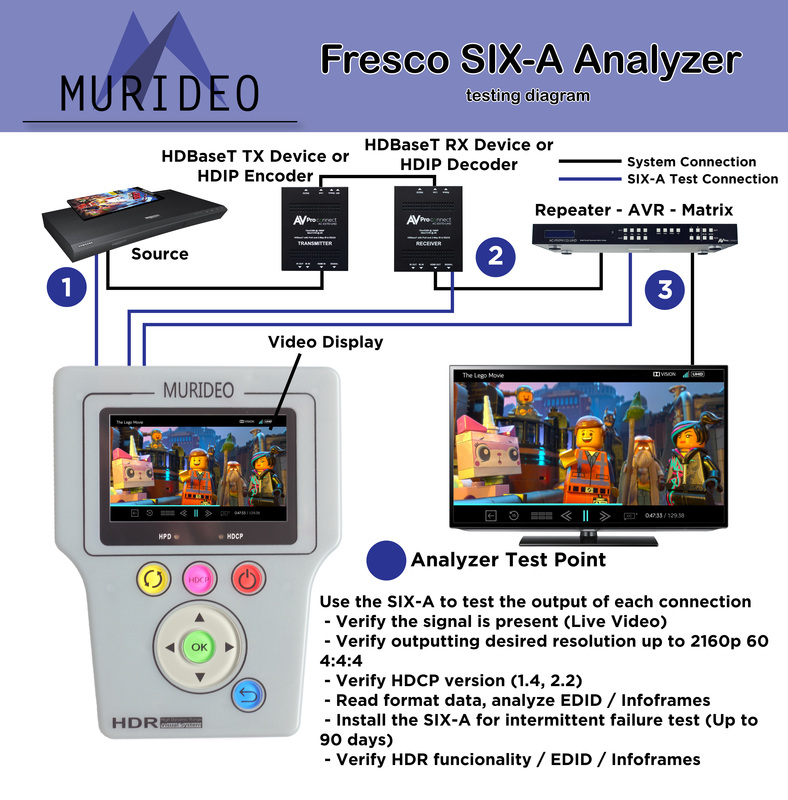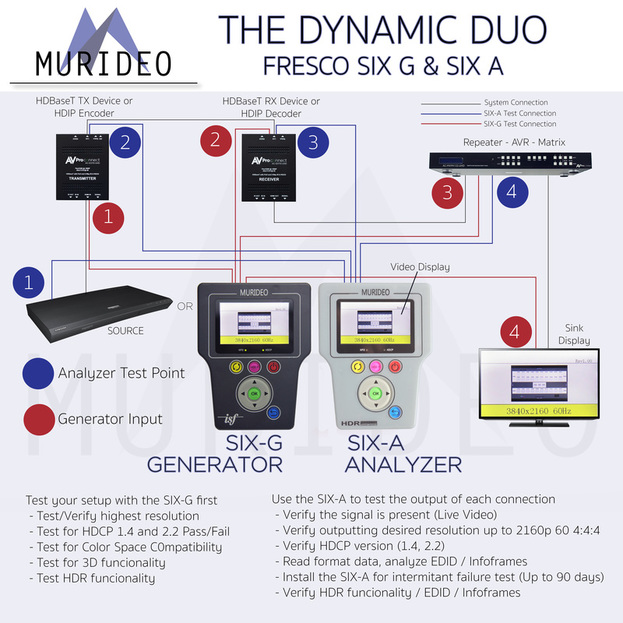|
Testing has never been so fun!
18 GBPS Signals Analyze any HDMI/DVI signals up to 18 GBPS (4096x2160P60 4:4:4). Test HDMI/DVI Cables up to 18GBPS, giving you the ability for full TMDS testing. Handheld Device Because this powerhouse comes in a handheld device you have the ability to use it very easily in the field. With it's own battery there is no need to have it plugged into a power source, just make sure you charge it before using. Analyze Over Time With the Fresco SIX-A Analyzer you can analyze and report HDMI Distribution over time. You choose minutes, hours, days, and you are testing down to the pixel. HDR, Metadata, EDIDand more With the Murideo Fresco SIX-A Analyzer you can test HDR signals, metadata, infoframes, and 2-channel and multi-channel Audio Confidence Tests. As well as read and write EDID's with our Advanced EDID analysis and tools.
0 Comments
You Need HDR TVs With Both Power and Finesse No, you can't get the TV you want You can't always get the TV you want But if you try sometime you find, You can get the TV you need OK - Forgive the play on the Rolling Stones - but High Dynamic Range and Wide Color Gamut are finally here. So what TV should I buy now? That question was an easy one in the old days - like last year! The TV you wanted last year was simply one that performed just like the Studio Monitor that was used to create content you watch. In tech terms, that was one that could be calibrated to closely match REC 709 color standards and BT.1886 EOTF. For the last five or six years that was not only possible, but downright affordable. Those days are over. You cannot buy a consumer TV that will even come close to matching the light output capability of the professional monitors used for High Dynamic Range. Power? Not nearly enough….. In Pre-HDR days, and by design, professional monitors had the light output capability of the old CRTs. That was about 100 Nits (a short term for the Luminance specification Candelas Per Meter Squared). Consumer TVs easily met and exceeded that performance spec, and we could get great images even in bright normally lit rooms. In this HDR era, light output for HDR professional monitors ranges from a current 4000 Nits to a proposed 10,000 Nits. You cannot buy anywhere near that kind of power for your home. This year's consumer HDR TVs will range from 400 to hopefully 1000 Nits. So you absolutely must buy the most powerful TV so you can get even remotely close to content creation's pictures. HDR sources will "Map the Color Volume" of HDR content down to the limited capability of your TV, so buying TVs with more power will get you better HDR pictures! Historically, specifications for TV light output have been far from accurate. We strongly suggest you measure light output power yourself, or at the very least find a review where measurements from credible reviewers are clearly documented so you will have a clue what you are actually buying. Finesse? Not anywhere near enough….. The terms "Local Area Dimming" and "Full Array LEDs" have been part of TV marketing for years now. With HDR, we can add "Local Area Blasting" since HDR will dim select areas and also blast more light and more colors in other select areas of your screen - all according to digital instructions coming along with HDR programs called "Metadata". Consider this simply the video equivalent of how content creation already controls multiple channels of surround sound. With HDR, content creation will now control color and light in select pixels on your screen. How "select" will the areas of your screen be? An older 2013 HDR Studio monitor already had over 1800 distinct areas of RGB that were individually controlled to go bright or dark. Don't expect your LED TVs to have anywhere near that amount of "Finesse". We are currently seeing a tenth of that considered OK for consumer LED, and a sixth of that considered very good. For OLED 4K TVs, there are potentially 8,000,000 select areas, but do not expect consumer content Metadata streams to have that level of Finesse in control. Self illuminating screens like OLED will have superb Finesse - as well as amazing blacks, but will not match the power of the brightest LEDs. OLEDs easily outperform LEDs when it comes to their finesse in black levels. LEDs easily outperform OLEDs in sheer light output. For HDR you want both, but you will have to choose for quite a while. Your choices should be based on how well you can control ambient light in your room. Brightly lit rooms may require the light output of the best LEDs, and bright light will ruin the look of your blacks with reflections. Reasonably well light controlled rooms will enable OLED's blacks and reasonable power levels to display superb dynamic range. So - What TV Do I buy? The answer is only a little different than past year's advice. In years past, we aimed to get as close as possible to the monitors used for content creation. Over the years in Pre-HDR days, we actually got there and succeeded! Right now you can merely approach professional monitor performance from afar. You will need to look for the best of both Power and Finesse for HDR viewing. For now, the very best of the HDR TV offerings will be your only logical choices for superior HDR viewing. With whatever brand and technology you end up buying - buy their top of their line model! Dolby Vision: http://www.dolby.com/us/en/technologies/dolby-vision/dolby-vision-white-paper.pdf SMPTE HDR https://www.smpte.org/sites/default/files/Study%20Group%20On%20High-Dynamic-Range-HDR-Ecosystem.pdf Written by Joel Silver Firmware (Most current rev is 1.71) - 1.68 and up have HDR enabled and should work with CalMAN 5.7 (the Generator still works with Previous versions from 5.5, but will not support HDR). There are THREE ways to use HDR on this product (Including with CalMAN) and you can see how those work here http://www.murideo.com/uploads/5/2/9/0/ ... ndix_a.pdf
Any metadata can be used with this device, so the possibilities are really endless... What's missing? 10BIT (in 4K) and BT2020 - while these items are missing from the current firmware they are in the final stages of being added. We anticipate a new firmware release that adds these functions to be publicly available by 05/20/2016. This will also correct any incorrect AVI Infoframe tags when sending HDR (this was due to the lack of BT2020, and address another issue on an earlier discussion) Can't get HDR to activate the display/projector? If you are using Calman 5.7 in HDR, this should not happen as the metadata is generated from the software - Alternately, if you are not using this please see the HDR Appendix listed above for help, the Metadata needs to be applied in the Murideo SIX-G PC Control software first. - Additionally, we have found that the default HDR Metadata in Firmware 1.68 - 1.71 does not work on all displays as the string was created when HDR was very much in its infancy. If you are having difficulty activating HDR on a display we have a small library of various Metadata Infoframes that we can provide as requested via email. We have verified compatibility with the following manufacturers - Sony, Samsung, LG, Hisense, JVC, Vizio What is coming? There are a few new things happening with the Murideo SIX-G. First and foremost you will now be able to do 4K 4:2:0 8-16 Bit. BT2020 will be enabled. Additionally you will have storage for up to 8 HDR Metadata Infoframes instead of 2. This will allow you much greater versatility in the field. In addition to this we are in the latter stages of releasing a custom "Pattern Uploader" so you can upload your own custom images to the generator. SIX-A - The SIX-A Analyzer is releasing very shortly (Appx 5/20/2016) and this will further enhance your ability to evaluate systems. You will be able to analyze an inbound signal from a source like a blu-ray to see your colorspace, HDR presence, Bit depth and more - in addition this will have a pixel level color checker, so when you do final confirmations using a blue ray you can see how accurate the desired color is coming from that pattern is. You can see what the playback device is doing to the image. Things to know/be prepared for - Once the new SIX-G firmware is released it will be a field update for 90% of you...the only exception is if you have version 1.68. If you have 1.68 firmware we will need to bring it into the shop. This is ONLY for 1.68 not prior or post version of that firmware, just contact [email protected] to make arrangements. DolbyVision - The new firmware also adds a new version of the Window pattern. This pattern has true DolbyVision support, enabling performance measuring and calibration on a DV display. This will require software support from CalMAN. The new window pattern will also allow window colors to be specified in YCbCr 444 or 422 formats and have zero colorspace changes until the data gets to the downstream device (display, processor, etc). This will of course depend on the output settings of the generator, and will also require software support to fully support. The previous Window pattern is still available and all existing software and workflows will continue to work as before. That's all for now on the Six-G but our Six-A will be here in mere days!!! |
Third Party Reviews & Articles
SIX-G Generator
Archives
July 2024
Categories |
|
|
© Copyright 2015-2023
Home Contact Us About Us Careers Warranty 2222 E 52nd Street North, Suite 101, Sioux Falls SD 57104 +1 605-330-8491 [email protected] |



 RSS Feed
RSS Feed